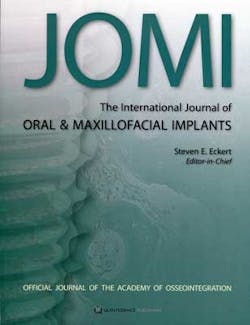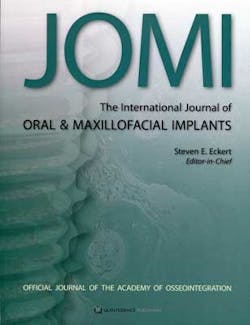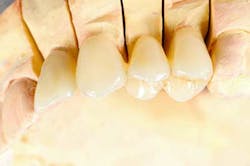AO, JOMI News: Accuracy of impression techniques, edentulous patients
Study exploring accuracy of impression techniques finds partial vs. complete edentulism may be a confounding factor
This study was published in the July/August issue of The International Journal of Oral and Maxillofacial Implants (JOMI, published by Quintessence), the official journal of the Academy of Osseointegration (AO).
Background: An accurate implant impression is necessary to generate an accurate cast, which is the milestone for the fabrication of a precisely fitting prosthesis. Several clinical and laboratory variables can affect the accuracy of an implant cast, with one of the most significant being the impression procedure. Although various implant impression techniques have been used to generate a definitive cast, the body of evidence shows controversy over which technique is most accurate. Furthermore, a previous review on accuracy did not account for partially vs. completely edentulous patients, but reported on them collectively.
ADDITIONAL READING |Academy of Osseointegration announces call for applications for 2015-2016 Osseointegration Foundation research grants
Author: Dr. Panos Papaspyridakos, Division of Postgraduate Prosthodontics, Tufts University School of Dental Medicine, and colleagues
Purpose: Seeking to evaluate the accuracy outcomes of digital and conventional impression techniques for partially and completely edentulous patients separately, researchers conducted a systemic review. They also sought to assess the effect of different variables — materials, angulation, and connection type — on the accuracy of implant impressions.
Materials and methods: A systemic review of the evidence was performed by searching publications indexed in the MEDLINE/PubMed, EMBASE, and CENTRAL databases from Jan. 1, 1980, to Sept. 1, 2013, and supplemented with a hand search of the literature. Information extracted and assessed from the articles included: study design, edentulous jaw, implant number, impression technique, connection type, abutment angulations, accuracy method implant brand, splint method, splint material, impression material, and the results of impression accuracy.
Results: Of the 88 articles selected for full-text reading, 76 studies were ultimately selected for inclusion in the research — four clinical and 72 in vitro. Studies were grouped according to edentulism status. A total of 41 studies were investigations of impressions for completely edentulous patients. For partially edentulous patients, 35 studies were found. Of the research on completely edentulous patients, most in vitro studies and three clinical studies demonstrated better accuracy with the splinted (15) vs. the nonsplinted technique (1), and nine showed no difference. One clinical study and half of the in vitro studies reported better accuracy with the open-tray (10) vs. the closed-tray technique (1), and 10 showed no difference. For partially edentulous patients, one clinical study and most in vitro studies showed better accuracy with the splinted (8) vs. the nonsplinted technique (2), and three studies showed no difference. The majority of in vitro studies showed better accuracy with the open-tray (10) vs. the closed-tray technique (1), and seven studies showed no difference. The only clinical study reported no difference.
ADDITIONAL READING |Standards of care for implant dentistry: an interview with Dr. Joseph Gian-Grasso, president of the Academy of Osseointegration
More information: To view this study in its entirety, visit: http://www.osseo.org/resources-accuracy-of-implant-impressions.html. To join AO and begin receiving JOMI (bimonthly), visit: www.osseo.org.
About The International Journal of Oral & Maxillofacial Implants — This highly regarded, frequently cited journal integrates clinical and scientific data to improve methods and results of oral and maxillofacial implant therapy. It presents pioneering research, seminal studies, emerging technology, position papers, and consensus reports, as well as the many clinical and therapeutic innovations that ensue as a result of these efforts. The editorial board is composed of recognized opinion leaders in their respective areas of expertise and reflects the international reach of the journal. Under their leadership, JOMI maintains its strong scientific integrity while expanding its scientific influence within the field of dentistry. It is published by Quintessence Publishing and is the official journal of the Academy of Osseointegration.
About the Academy of Osseointegration — With 6,000 members in 70 countries around the world, the Academy of Osseointegration (AO) is recognized as the premier international association for professionals interested in implant dentistry. AO serves as a nexus where specialists and generalists can come together to evaluate emerging research, technology and techniques, share best practices, and coordinate optimal patient care using timely, evidence-based information. Follow AO on Facebook and Twitter.



